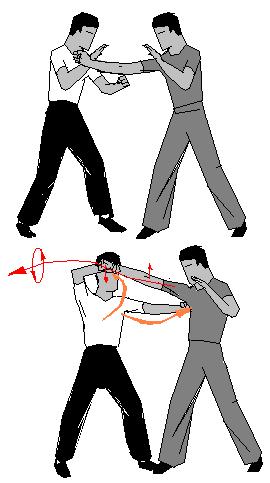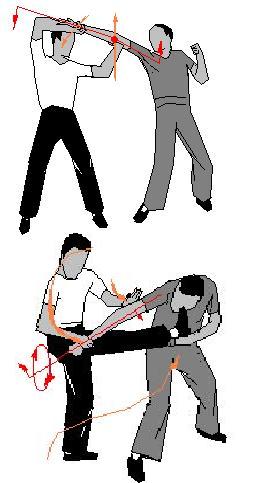|
|
|
Armchair Strategist's Martial Arts Pages |
 |
Partial Locks
In many doctrines, locks
are used as a means of restraining someone -the ultimate goal to
pacify an opponent using pain-compliance without actually doing
any significant damage to them. I question the logic to this. In
a self-defence scenario I am reticent to advocate using your
hands to restrain someone unless you are very sure that for as
long as it takes, nobody else is going to attack you. What is
more, if you haven't damaged the opponent, they are
physically/mentally able to further the fight once you release
the lock.
More times than not locks require grabbing a limb -which is
sometimes easy /sometimes difficult -depending on how your
opponent fights. Therefore locks cannot be relied upon as a
primary strategy -sometimes it is more logical to go for strikes
and forget locks.
But locks can be very practical and robust. With locks you can:
All locks can be countered
although it is true that the most reliable anti-lock defence is
not to be caught in the first place.
I suggest employing locks extensively but only for short periods
simultaneously with or immediately followed by viscous attacks.
This is what I mean by partial locking -not locking for its own
sake but merely to provide openings for attack. As such the lock
doesn't need to be completely 'tying up' or difficult to get out
of because its only temporary.
 |
Demo sequence Block and grab his lead punch, rotating and pulling upwards as shown (left). This locks his elbow and will naturally turns his body away from you exposing his ribs (in the lower part of the hollow of his armpit). Alternatively strike upwards into his armpit or upper arm, the latter may break his arm (because it cannot move with the force) and/or dislocate his elbow or shoulder -but requires good accuracy and a 'clean' impact. You can reinforce the locking element by pushing upwards on his inverted and stretched elbow joint whilst simultaneously pulling down on his locked wrist (right top). This is very painful and effective for short periods but can be struggled out off. The locked elbow is particularly vulnerable to dislocation/breaking. To switch to a more beneficial position, suddenly undo the lock, keeping his arm pulled straight and rotate it in the opposite direction, pulling down. Again this locks his arm -provided that it remains straight. Apply pressure to his elbow or upper arm to prevent him bending it. Once again, if hit hard enough, the elbow can easily be broken. Attack Immediately, such as with the rising kick shown (right bottom).
|
 |